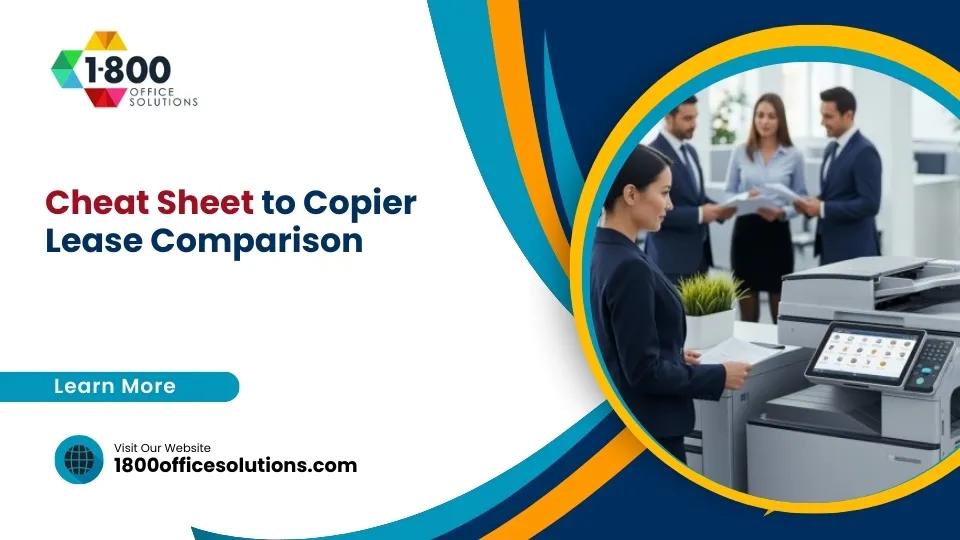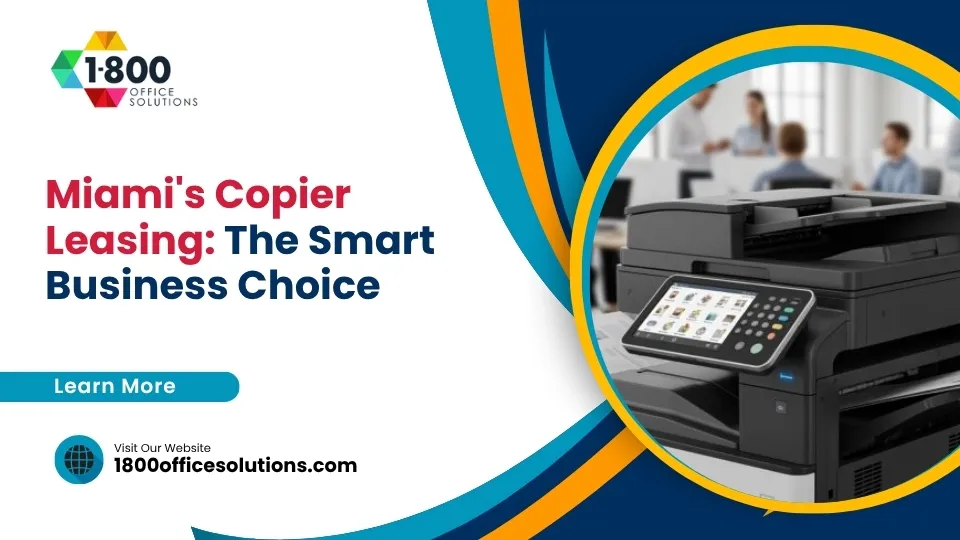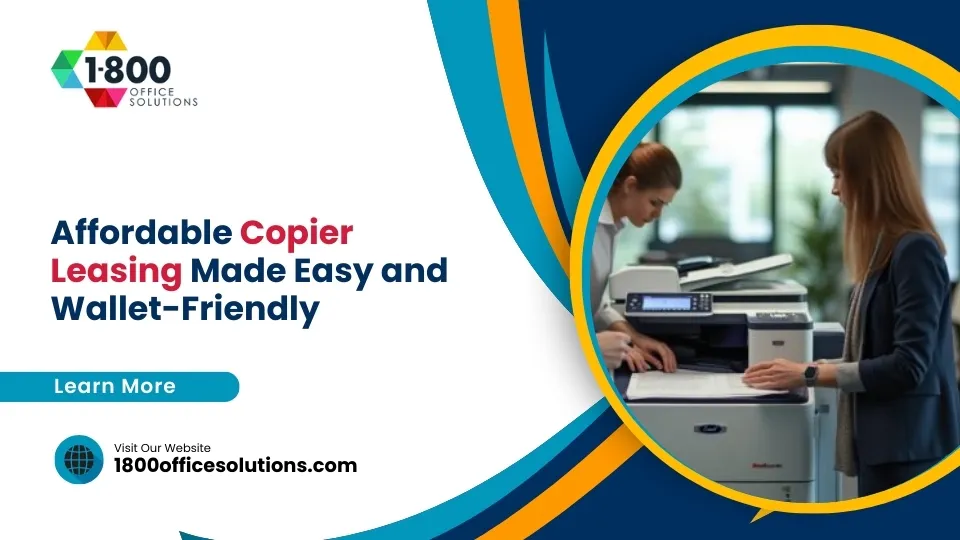Lease a Copier Without Breaking the Bank
Ever had that moment when your office copier jams for the fifth time in a day, and you think, “There has to be a better way”? You’re right—there is!
Affordable copier leasing has become the go-to solution for businesses wanting modern technology without draining their bank accounts. Think of it as having your cake and eating it too: access to cutting-edge equipment with manageable monthly payments that keep your accountant happy.
Here’s the scoop on what makes leasing work for thousands of businesses:
| Key Aspects | Details |
|---|---|
| Monthly Cost | $65-900 depending on features and volume |
| Typical Terms | 24-60 months (36 months most common) |
| What’s Included | Equipment (maintenance and toner often separate) |
| Credit Requirements | 3-5 years business history or personal guarantee |
| End of Lease | Return, upgrade, or purchase options |
If you’re like most business owners I talk with, you’re constantly juggling technology needs against budget realities. That ancient copier in your office might still work (sometimes), but it’s probably costing you more in lost productivity and frustration than you realize.
Leasing a copier offers a practical middle ground that makes perfect sense for growing businesses. With monthly payments starting at just $65 for basic models—about what you might spend on office coffee each month—you can access professional equipment without the sticker shock of purchasing outright.
What I love about explaining copier leasing to clients is seeing their relief when they understand the flexibility it provides. Need a basic black-and-white workhorse? That’s at the lower end of the price spectrum. Running a busy marketing firm that needs high-volume color production? Higher-end models with all the bells and whistles might run $500+ monthly, but they deliver capabilities that transform your workflow.
“For many companies, copy machine leasing makes better business sense than purchasing,” as industry experts consistently point out. And they’re right—the approach preserves your capital for growth opportunities while giving you predictable monthly expenses you can budget for confidently.
The real magic happens when you customize your lease package. Many of our clients bundle hardware, software, maintenance, support, and even consumables into one tidy monthly payment. And when technology inevitably advances (as it always does), you’re not stuck with an obsolete machine—simply upgrade at the end of your term.
Whether you’re running a small nonprofit with tight budget constraints or scaling up a business with expanding document needs, affordable copier leasing provides a smart path forward without compromising quality or capabilities.
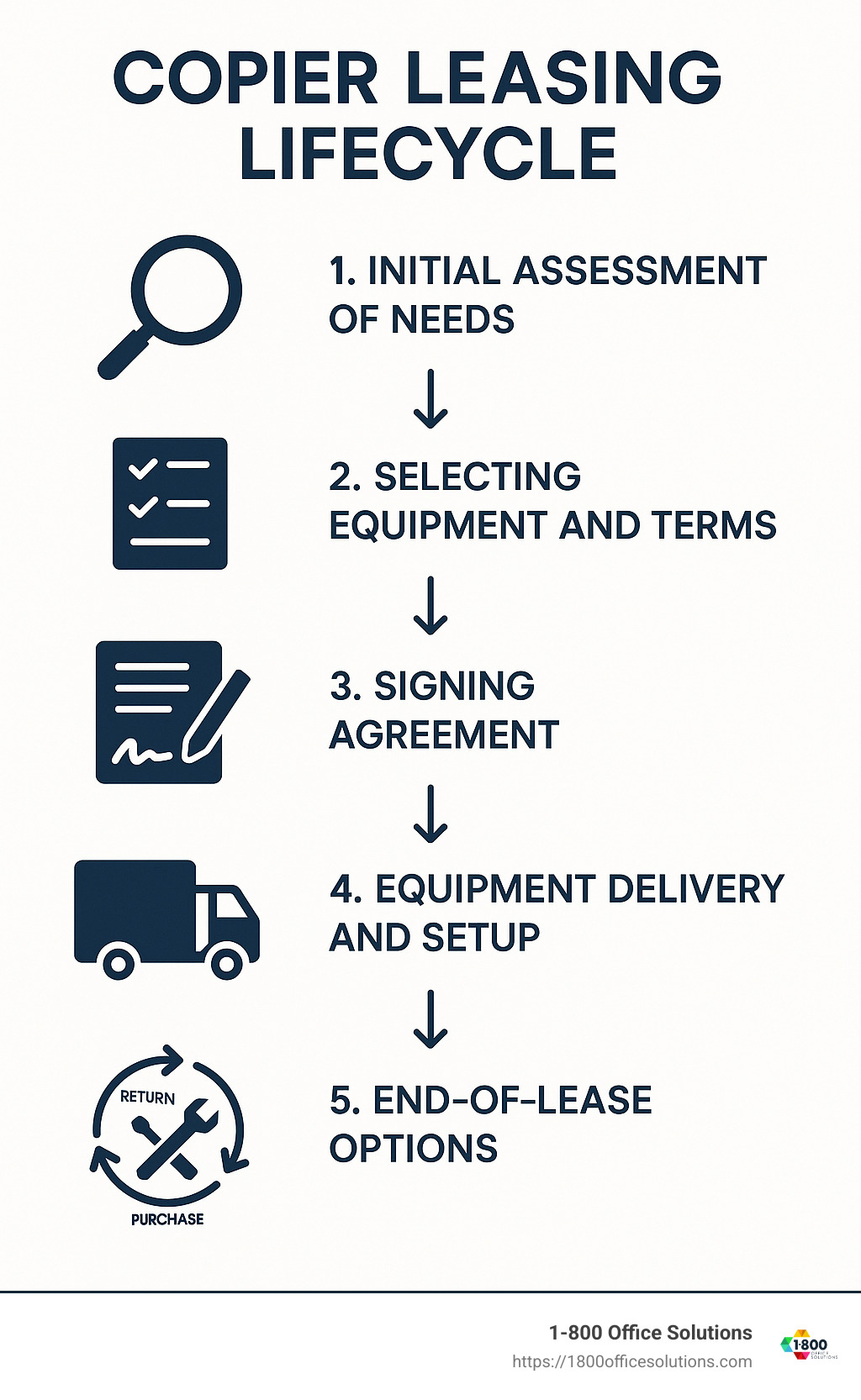
What Is Copier Leasing & How It Works
Think of affordable copier leasing as renting a car, but for your office equipment. Instead of shelling out thousands upfront, you make manageable monthly payments while enjoying all the benefits of a modern copier or multifunction device.
At its heart, copier leasing is a financial arrangement that puts cutting-edge technology within reach of businesses of all sizes. You’ll get the equipment you need today while preserving your cash flow for other priorities – whether that’s hiring new staff, marketing, or simply keeping a healthy reserve for unexpected expenses.
Most businesses choose from three main lease types, each with distinct advantages:
Fair Market Value (FMV) Lease is the most popular option for good reason. Your monthly payments stay lower because you’re essentially paying for the equipment’s depreciation during your use period. When your lease ends, you have three flexible choices: return the equipment, upgrade to something newer (perfect as technology evolves), or purchase it at whatever the fair market value happens to be then.
$1 Buyout Lease works more like financing a purchase. Your monthly payments run higher than an FMV lease, but at the end, you own the equipment outright for just one dollar. This option makes sense when you’re confident you’ll want to keep the equipment long-term.
Operating Lease functions purely as a rental from an accounting perspective. This structure offers potential tax advantages since the entire payment typically qualifies as a deductible business expense rather than a capital expenditure.
Most companies opt for lease terms between 24 and 60 months, with 36 months standing as the industry sweet spot. It’s worth noting that while longer terms reduce your monthly payment, they may increase your total cost over time.
“We see the greatest satisfaction from clients who align their lease term with their technology refresh cycle,” notes our leasing specialist from the Tampa office. “For rapidly growing businesses, shorter terms provide more flexibility, while established operations with stable needs often benefit from longer terms.”
Your monthly payment calculation hinges partly on the equipment’s residual value – what it’s projected to be worth when your lease ends. Higher residual values (typical with FMV leases) translate to lower monthly payments.
Curious about exploring all aspects of copier leasing in greater depth? We’ve compiled a comprehensive resource covering everything from contract negotiation to end-of-lease strategies in our Copy Machine Lease Ultimate Guide.
The Leasing Process Step-by-Step
Getting started with affordable copier leasing is surprisingly straightforward. Here’s what you can expect:
First comes the assessment phase. You’ll work with a specialist to determine your actual copying needs – considering factors like monthly volume, required features, and growth projections. At 1-800 Office Solutions, we make this simple with a user-friendly online configurator that helps pinpoint the perfect equipment match.
Next, you’ll complete a lease application. Most leasing companies review your business credit history, typically looking for 3-5 years of established operations. Don’t worry if you’re a newer venture – options exist for younger businesses, including personal guarantees that can often be removed after establishing a positive payment history.
After approval, you’ll review and sign your lease agreement. This is your opportunity to negotiate favorable terms. Smart lessees often secure provisions like caps on annual increases, performance guarantees, and inclusion of installation and training services.
The delivery and installation phase follows. Trained technicians will set up your equipment and ensure it’s properly connected to your network. Many providers now offer remote installation support via video conferencing tools to reduce costs without sacrificing quality.
Finally, if you’ve opted for a service agreement (which we highly recommend), this will be established to cover maintenance, toner supply, and repairs according to your specific needs.
“The process was much smoother than I expected,” shares Maria, an office manager from Philadelphia. “We leased a Xerox WorkCentre for our accounting firm, bundling 7,000 black and white copies and 2,000 color copies monthly for $287. The supplier even threw in complementary supplies as a welcome bonus.”
Copier Leasing vs Short-Term Rental
While both leasing and renting provide access to equipment without buying it outright, they serve distinctly different business needs.
Affordable copier leasing typically involves a longer commitment, usually 24-60 months. This longer term translates to lower monthly payments and often includes options for ownership at the end. Leasing requires credit approval but rewards you with potential tax benefits as the payments can often be deducted as business expenses.
Short-term rental, by contrast, offers maximum flexibility with daily, weekly, or monthly agreements. While the per-month cost runs higher, you gain the ability to return the equipment whenever your needs change, with minimal credit requirements or long-term obligations.
Rental makes perfect sense for seasonal businesses experiencing predictable fluctuations in demand. Consider tax preparation firms that need additional copying capacity from January through April, but would see that extra equipment sitting idle the rest of the year.
Event planning companies often rent copiers for specific projects or conferences, returning them when the event concludes. Similarly, businesses dealing with disaster recovery situations appreciate the ability to quickly secure needed equipment without long-term commitments.
“We’ve found the sweet spot is sometimes a combination approach,” explains David, an IT director at a growing law firm in Atlanta. “We maintain two leased copiers for our consistent base volume, then supplement with short-term rentals during major litigation cases when our document production needs temporarily skyrocket.”
This hybrid strategy allows businesses to maintain cost efficiency while ensuring they have the right equipment capacity precisely when they need it – no more, no less.
Affordable Copier Leasing vs Buying: Pros, Cons & Tax Breaks
Let’s face it – deciding whether to lease or buy a copier isn’t always straightforward. Like choosing between renting or buying a home, both options have their place depending on your business situation.
When I talk with clients about this decision, I always start by understanding their priorities. Are you more concerned with preserving cash flow today or minimizing total costs over time? Do you want the latest technology, or are you comfortable using the same equipment for years?
Leasing Advantages:
Capital preservation
is often the biggest draw for leasing. Instead of writing a big check upfront, you can keep that money working in your business. A boutique marketing agency in Dallas told me recently, “That $15,000 we didn’t spend on a copier went straight into our digital advertising campaign, which brought in three new clients within months.”
Technology refresh opportunities keep you current without the hassle of selling outdated equipment. When that new model with double-sided scanning and cloud integration comes out, you’re not stuck with yesterday’s technology.
Predictable budgeting means no surprises – your monthly payment stays consistent, making financial planning much simpler. This predictability is especially valuable for businesses with seasonal cash flow.
Tax benefits can be substantial, as lease payments are typically fully deductible as operating expenses. This provides immediate tax advantages rather than depreciating a purchased asset over time.
Included maintenance often comes bundled with leases, removing the worry about repair costs or finding qualified technicians when problems arise.
Buying Advantages:
If you’re planning to keep your equipment for many years, long-term cost savings can be significant. After the purchase price is paid, you’re free from monthly payments.
Asset ownership strengthens your balance sheet, which can be important when seeking financing for other business needs.
No contract restrictions means freedom to modify, relocate, or even sell your equipment without needing approval from a leasing company.
Resale value gives you the opportunity to recoup some costs when you eventually upgrade, though office equipment typically depreciates quickly.
No usage limits eliminate concerns about excess page charges that sometimes come with lease agreements.
The tax implications deserve special attention. When purchasing, Section 179 of the IRS tax code allows businesses to deduct the full purchase price of qualifying equipment in the year it’s put into service (up to certain limits). This can dramatically reduce the effective first-year cost of buying.
With affordable copier leasing, you spread the tax benefits across the lease term, deducting each payment as an operating expense. This provides steady benefits rather than front-loading them.
As the IT director at a Michigan accounting firm shared with me, “We purchased our Toshiba 4500 Series outright for $11,000. For our situation, the Section 179 deduction made buying more financially advantageous than leasing. Plus, we knew our volume needs were stable for the foreseeable future.”
Why leasing a business copier is better than buying
Top 5 Perks of Affordable Copier Leasing
Upgrade freedom
might be my favorite leasing benefit to highlight with clients. Technology changes so quickly, and leasing lets you evolve with it. A private medical practice in Burbank shared their experience: “We started with a refurbished Ricoh MPC4502 on a 5-year lease with a $1 buyout option. When our patient load increased dramatically after two years, we needed something faster. Our leasing company helped us upgrade while keeping our monthly payment manageable.”
Bundled service agreements take the guesswork out of maintenance. When toner runs low or parts wear out, it’s all covered in your monthly payment. As our Charlotte service team often explains, “With a service plan, you pay one predictable bill based on your print volume, and we handle everything else – supplies, parts, and repairs.”
Predictable payments create stability in your budget. Rather than facing an occasional large repair bill or supply purchase, you know exactly what your copying will cost each month. For growing businesses watching every dollar, this consistency is invaluable.
Tax advantages come immediately with leasing. Unlike purchasing (where you typically depreciate the asset over time), lease payments are generally 100% tax-deductible as business expenses right away. Always consult your tax advisor, but this benefit often tips the scales toward leasing for tax-conscious businesses.
No large down payment means you can preserve your capital for revenue-generating activities. Leasing typically requires minimal upfront investment – perhaps just the first and last month’s payment. This frees up cash for marketing, inventory, or other operational needs that directly impact your bottom line.
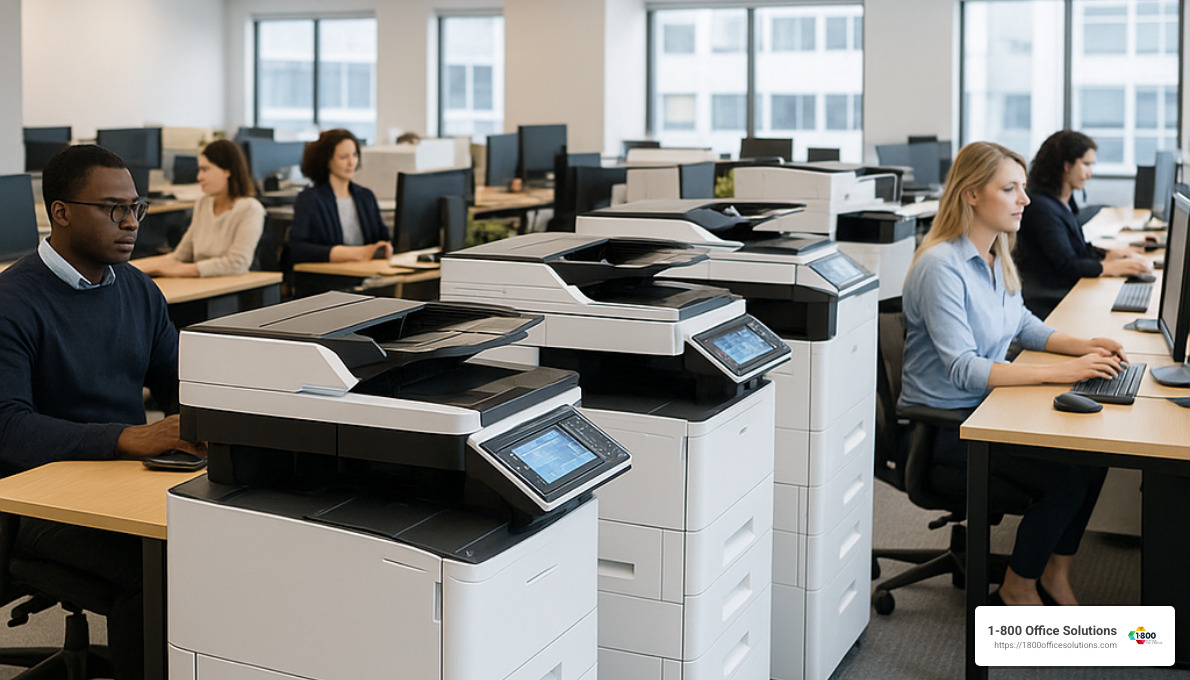
Common Myths About Leasing
Over my years helping businesses with their office equipment needs, I’ve heard plenty of misconceptions about leasing. Let’s clear up some of the most common ones:
Myth 1: Leasing Always Costs More Long-Term
While the raw numbers might suggest this, it’s not the complete picture. Yes, if you add up all lease payments, they often exceed the purchase price. However, this overlooks the time value of money, tax advantages, and the benefit of regularly upgrading to newer technology. When calculating true cost of ownership, consider all factors, not just the basic math.
Myth 2: Leases Are Full of Hidden Clauses
This concern stems from unfortunate experiences with less reputable leasing companies. At 1-800 Office Solutions, we pride ourselves on transparent agreements with no surprises. That said, always review any contract carefully, paying special attention to:
- Automatic renewal provisions
- End-of-lease notification requirements (often 90 days)
- Excess usage charges and how they’re calculated
- Maintenance responsibilities and service response times
Myth 3: Upgrading Mid-Lease Incurs Penalties
Many quality leasing programs actually build in upgrade paths. One of our Miami customers recently told me, “When we unexpectedly landed a major client, we suddenly needed more copying capacity. Our leasing company simply rolled the remaining balance into a new lease for a higher-capacity machine. No penalties, no hassle.”
Myth 4: All Leases Include Maintenance
Service agreements and equipment leases are typically separate arrangements, though they’re often bundled for convenience. This separation actually benefits you by providing the flexibility to adjust service levels without disrupting your equipment lease terms.
Myth 5: You Need Perfect Credit
While established credit certainly helps secure better rates, we work with businesses across the credit spectrum. Startups and companies rebuilding their credit can often qualify through alternative programs, perhaps with a slightly higher rate or security deposit. Don’t let credit concerns stop you from exploring your options.
When approached with the right information, affordable copier leasing can be a smart strategic choice that aligns with your business goals while preserving your capital for growth opportunities.
2025 Price Guide: How Much Does It Cost?
Navigating copier leasing costs can feel overwhelming, but I’m here to help you understand what to expect in 2025. Let’s break down the numbers in a way that makes sense for your budget planning.
Monthly Lease Costs by Copier Type:
The price of affordable copier leasing varies widely depending on what you need. For basic black and white copiers, you’re looking at about $50-$200 monthly. If color printing is essential for your business, expect to pay between $100-$300 per month.
Multifunction printers (MFPs) that combine printing, scanning, copying, and faxing typically run $100-$500+ monthly, depending on capabilities. And if you need high-volume production equipment for intensive printing needs, those leases generally range from $195-$920 per month.
To put these numbers in perspective, buying these machines outright would cost you around $4,000-$5,800 for a decent used office copier. New standard models (up to 55 pages per minute) average about $13,000, while heavy-duty production models can reach up to $35,100!
Your location plays a surprising role in pricing too. A business in Manhattan will typically pay more than one in Grand Rapids for the identical equipment. And naturally, your lease term affects your monthly payment – a 60-month lease offers lower monthly payments than a 36-month lease, though you’ll likely pay more in total over the full term.
3-Year Total Cost of Ownership Comparison
| Acquisition Method | Upfront Cost | Monthly Cost | 3-Year Total | Maintenance | End Value |
|---|---|---|---|---|---|
| Purchase (New) | $13,000 | $0 | $13,000 | $1,800-$3,600 | $3,000-$5,000 |
| Purchase (Used) | $5,000 | $0 | $5,000 | $2,400-$4,200 | $500-$1,500 |
| FMV Lease | $0-$500 | $175-$300 | $6,300-$10,800 | Often included | $0 (Return) |
| $1 Buyout Lease | $0-$500 | $250-$400 | $9,000-$14,400 | Often included | Equipment ownership |
Industry data for 2025 shows that copier leases typically cost between $100 and $900 per month, with low-volume machines available for as little as $65 monthly. This wide range means businesses of all sizes – from solo entrepreneurs to large corporations – can find an option that fits their budget.
More info about Unexpected Costs of Lease a Copier Machine
Budget Benchmarks for Small Businesses
Different types of businesses have their own unique needs and constraints. Here’s what I’ve seen work well for various organizations:
For low-volume operations printing under 3,000 pages monthly (think home offices or small professional services), a basic multifunction printer at $65-$125 monthly usually does the trick. I recently worked with a small church in Woodsboro, TX with a tight budget cap of $600. They were thrilled to find a lease for just $89 monthly that included scanning and duplex printing – everything they needed without breaking the bank.
Mid-range small businesses printing 3,000-10,000 pages monthly (like medical practices, law firms, and real estate offices) typically benefit from mid-volume multifunction copiers in the $150-$300 monthly range.
Nonprofits deserve special mention – many qualify for discounted rates 10-15% below standard pricing, along with grant-friendly payment structures. One community organization in Lansing shared with me how they secured a refurbished Canon ImageCLASS for just $99 monthly, including service. The dealer even worked with their grant-based funding schedule to align payments with their disbursements – exactly the kind of flexibility that makes affordable copier leasing work for organizations with unique financial situations.
Hidden & Upfront Fees to Watch
I always tell my clients to watch for these potential extra costs when budgeting for their lease:
Delivery & installation might seem like they’d be included, but some companies charge $100-$300 for these services. Always ask upfront if these costs are covered.
Be aware of documentation fees – those $50-$150 processing charges for paperwork. The good news? These are often negotiable if you bring them up before signing.
Don’t forget about insurance requirements. Most leases require you to insure the equipment, either through your existing business insurance or a separate policy, which can add $10-$30 to your monthly costs.
Excess usage charges can really add up if you exceed your monthly allowance. These typically range from $0.01-$0.15 per page, with color pages costing more than black and white.
Breaking a lease early? Brace yourself for early termination fees, which often require you to pay all remaining lease payments – a substantial hit to your budget.
And when your lease ends, you might be responsible for return shipping costs, ranging from $200-$500 depending on the equipment size and your location.
One Atlanta business owner recently told me, “We were completely blindsided by a $250 charge for removing our old equipment when the new leased copier arrived.” This is why I always recommend asking about any potential fees that aren’t explicitly listed in your quote – better to know before you sign than face surprise charges later.
Cutting Your Bill: Factors & Money-Saving Strategies
Several factors influence the cost of your copier lease, and understanding them can help you secure more affordable copier leasing terms:
Print volume is perhaps the most crucial factor to consider. Being realistic about your monthly page count saves money in two ways – you avoid paying for capacity you don’t use, and you steer clear of those pesky overage charges that can quickly add up. One Houston customer shared with us: “We initially overestimated our needs by about 5,000 pages monthly. Rightsizing saved us nearly $100 per month!”
Copier speed makes a significant difference in your monthly bill too. Speed is measured in pages per minute (ppm), and while it might be tempting to go for the fastest machine available, most small businesses producing 3,000-5,000 pages monthly do perfectly fine with a 20-30 ppm device. Only consider those speedier 40-70 ppm models if your team regularly prints large batch jobs or faces tight deadlines.
The color versus monochrome decision can impact your costs dramatically. Color capabilities typically increase lease costs by 30-50%. If your team only needs color occasionally, consider a black and white copier with a separate desktop color printer for those specific needs. This hybrid approach often delivers substantial savings.
Lease length is another consideration with clear tradeoffs. Longer terms (48-60 months) reduce your monthly payments but increase the total cost over time and delay technology upgrades. Shorter terms (24-36 months) cost more monthly but provide greater flexibility to adapt as your business evolves.
Your credit score plays a significant role too. Better business credit scores secure more favorable rates. For newer businesses, it might be worth spending a few months improving your credit profile before leasing – even a small rate reduction compounds into significant savings over a multi-year lease.

Here are some proven strategies to reduce your leasing costs:
Consider refurbished units for substantial savings. Off-lease copiers with low page counts often deliver like-new performance at 30-50% lower cost. A private practice in Burbank told us, “We leased a refurbished Ricoh MPC4502 previously owned by another practice in the area. It was virtually indistinguishable from new but saved us about $100 monthly.” These gently-used machines often come from businesses that upgraded before their lease ended or from companies that went out of business.
Comparison tools can be your best friend during the shopping process. Online configurators and quote comparison services help you evaluate multiple offers quickly. Our Philadelphia customers regularly report saving up to 20% simply by comparing quotes from different providers. We’ve made this even easier with our online quote tool that provides instant comparisons from multiple vendors.
While bundling service with your lease seems convenient, keeping service separate often saves money in the long run. Bundled agreements typically lock you into fixed page counts, while separate service agreements allow you to adjust service levels as your needs change. One of our Michigan clients reduced their monthly costs by $75 when they switched to a separate service agreement that better matched their actual usage patterns.
Timing your negotiations can yield surprising benefits. The end of month, quarter, or fiscal year often results in better deals as sales representatives work to meet their quotas. One savvy customer in Charlotte told us, “We waited until December 28th to finalize our lease. The sales rep was eager to close before year-end and threw in three months of free service!”
Rightsizing your equipment is perhaps the simplest way to reduce costs. Many businesses lease more capacity than needed, paying a premium for features they rarely use. Match your equipment to actual usage patterns, not occasional peak demands. For those rare high-volume periods, consider short-term rentals to supplement your leased equipment.
Negotiation Hacks for Affordable Copier Leasing
Savvy negotiation can significantly reduce your leasing costs. Here are expert tactics from our team at 1-800 Office Solutions:
Zero-down agreements preserve your capital for other business needs. While some leases require first and last month payments upfront, many leasing companies will waive these with good credit or a slightly higher monthly rate. This approach is particularly helpful for seasonal businesses or startups watching their cash flow.
Rate caps on service contracts protect you from unexpected cost increases. If bundling maintenance, negotiate a cap on annual increases. “Maintenance agreement rates typically increase 10% each year,” notes our service manager. “We always recommend negotiating prior to signing to avoid these annual hikes.” Getting this in writing can save thousands over a multi-year lease.
Performance guarantees provide valuable protection against equipment problems. Include a written clause requiring replacement of equipment that fails to meet manufacturer specifications. A customer in Winston-Salem shared, “When our copier experienced repeated paper jams, the performance guarantee in our lease required the provider to replace it with a newer model at no additional cost.” This saved them from being stuck with problematic equipment for years.
Quarterly reviews of your usage patterns allow for timely adjustments. Request scheduled quarterly reviews to adjust copy allotments based on seasonal business fluctuations, potentially saving hundreds in overage charges. One accounting firm adjusts their plan every tax season, increasing their allowance from January through April, then reducing it for the remainder of the year.
Avoiding auto-renewal clauses gives you control over your commitment. Ensure your lease doesn’t include an “evergreen clause” that automatically renews. Instead, negotiate a 30-day renewal clause that gives you control over continuation. Many businesses have been unpleasantly surprised by automatic renewals they didn’t anticipate.
Bundled installation and training save on startup costs. Negotiate to include delivery, installation, network setup, and staff training in your lease package rather than paying separately for these services. These “extras” can add up to $500-$1,000 in value.
As one of our Detroit customers advised, “Always ask for more than you expect to get. We requested three months of free service, expecting to be negotiated down to one month, but surprisingly received all three.” This approach works because most leasing companies build negotiation margins into their initial offers.
Financing & Credit Options Explained
Various financing structures accommodate different business situations:
Fair Market Value (FMV) Leases offer the lowest monthly payments but require returning the equipment at lease end (or purchasing at then-current market value). These work wonderfully for businesses prioritizing cash flow and regular technology updates. A marketing agency in Miami told us, “We change our equipment every three years to stay current with technology. FMV leases give us that flexibility without breaking the bank.”
$1 Buyout Leases function more like financing, with higher monthly payments but ownership at lease end for just $1. This arrangement suits businesses planning long-term use of the equipment. A family-owned print shop in Grand Rapids explained, “We know we’ll use our production printer for at least seven years, so the $1 buyout made more sense for us.”
Lease-to-Own Programs provide a middle ground, often starting with lower payments that apply toward eventual ownership. “Our lease-to-own program offers interest-free installments and manageable payment plans to meet your financial status,” explains our finance specialist in Atlanta. These programs combine the benefits of leasing with the long-term value of ownership.
For businesses with credit challenges, several options exist:
No-credit-needed programs make equipment accessible to more businesses. Some providers offer leasing without traditional credit requirements, instead basing approval on business cash flow and bank statements. These programs typically require 6-12 months of business banking history showing consistent revenue.
Bad credit approval programs recognize that past financial challenges don’t define your business’s future. Many leasing companies work with businesses rebuilding credit, though rates may be higher initially. As you establish payment history, you can often renegotiate for better terms.
Flexible payment plans accommodate businesses with irregular cash flow. Seasonal businesses particularly benefit from payment structures aligned with their revenue patterns, with higher payments during peak seasons and lower payments during off-seasons.
“No Credit? Bad Credit? All Are Welcomed,” states our financing partner’s policy. “Our mission is to make copier financing accessible for all.” This inclusive approach has helped hundreds of businesses access the equipment they need despite credit challenges.
Startups and new businesses often face stricter requirements. If your business has less than 3-5 years of history, be prepared for personal guarantees from business owners, higher security deposits (typically 1-2 months’ payment), and shorter initial lease terms with renewal options.
One promising approach: “Request annual credit reviews to potentially remove personal guarantees as your business establishes payment history,” suggests our leasing specialist in Tampa. This strategy has helped many young businesses gradually transition to more favorable terms as they prove their reliability.
Choosing the Right Copier & Lease Agreement
Finding the perfect copier for your business is just as crucial as negotiating favorable lease terms. After all, you’ll be working with this equipment daily for years to come!
Multifunction Devices (MFPs) have become the go-to solution for most businesses, and for good reason. These versatile machines combine printing, copying, scanning, and sometimes faxing in one space-saving unit. As an office efficiency expert recently told us, “An all-in-one machine gives you the most bang for your buck in a small business setting.” Our customers consistently report that consolidating multiple devices into one MFP not only saves valuable office space but also simplifies maintenance and training.
When considering color capabilities, think carefully about your actual needs. Color copiers cost significantly more to lease and operate—with per-page costs of 6-9 cents compared to just 1-2 cents for black and white. One of our clients, a law firm in Detroit, realized they were paying for color capabilities they rarely used. By switching to a high-quality black and white model with a separate small color printer for occasional needs, they saved over $2,100 annually.
For businesses that regularly produce architectural drawings, posters, or oversized marketing materials, large-format options might be necessary. These specialized devices typically start at around $300 monthly for leasing. A real estate agency in Philadelphia told us their large-format printer became an unexpected profit center when they began offering printing services to neighboring businesses!
Space-conscious? Desktop vs. floor models is an important consideration. Desktop units take up less room but handle lower volumes. If your business makes fewer than 2,000 copies monthly, these more affordable copier leasing options (starting around $65/month) might be perfect. A small accounting firm in Lansing shared, “Our desktop MFP fits perfectly in our reception area and handles all our daily needs without breaking the bank.”
Don’t overlook the value of used/refurbished equipment. Off-lease copiers often have years of useful life remaining at substantially lower costs. As reported in a recent industry publication, “Used/off-lease copiers often have low page counts and current feature sets at a fraction of new prices.” One of our Miami customers was thrilled to find they could lease a professionally refurbished enterprise-grade copier for less than a new mid-range model.
When reviewing lease agreements, pay special attention to these critical elements:
Upgrade clauses can be a lifesaver as your business grows or technology advances. Ensure your lease allows for technology upgrades, ideally applying a portion of your payments toward new equipment. A growing marketing agency in Charlotte initially leased a basic model, but their rapid expansion required more capabilities. Their upgrade clause allowed them to transition to a higher-capacity model mid-lease without penalties.
Bundled maintenance decisions impact both your budget and peace of mind. Determine whether service is included or separate, and exactly what’s covered. Some businesses prefer the predictability of all-inclusive agreements, while others benefit from separate arrangements they can adjust as needs change.
Toner & parts coverage varies widely between contracts. Some agreements include all consumables, while others cover only certain components. Be especially clear about high-wear items like drums and fusers, which can be costly to replace.
Service Level Agreements (SLAs) establish expectations for support. Look for guaranteed response times for service calls, ideally next business day or better. A marketing agency in Brooklyn shared this valuable insight: “We needed high-quality color output for client presentations. Our lease includes a professional-grade color MFP with guaranteed 4-hour service response time, which has been crucial for meeting client deadlines.”
What’s Inside a Budget-Friendly Contract
A well-structured lease agreement should clearly outline all terms and conditions without hiding fees in the fine print. Here’s what to look for in a truly budget-friendly contract:
Maintenance coverage forms the backbone of a good service agreement. Comprehensive coverage should include preventive maintenance, repairs, and emergency service. Our service manager in Grand Rapids explains it well: “Parts are covered under the supplies and service agreement except for customer-supplied third-party networking equipment.” This clarity helps prevent disputes later on.
The way your contract handles toner management can significantly impact both convenience and costs. Clarify whether toner is included, how replacement is handled, and if automatic shipment is available. Some of our most satisfied customers love services that monitor usage remotely and ship toner before they run out. A dental office in Atlanta told us, “Never running out of toner has eliminated those panic moments before important patient presentations.”
Detailed repair protocols protect you when things go wrong. The agreement should specify response times, whether loaner equipment is provided during extended repairs, and who’s responsible for various types of damage. A clear understanding of these protocols prevents surprises when you’re already dealing with equipment downtime.
Don’t settle for vague promises when it comes to response time guarantees. Look for specific commitments like “next business day service” rather than general assurances. Our operations team notes that “Service typically occurs next business day, with faster response in metro areas and slower service in remote locations.” Businesses in rural areas should be especially careful to confirm realistic service timeframes.
Every contract includes a monthly page allowance with excess click charges for overages. Ensure these charges are reasonable (typically $0.01-$0.02 for B&W, $0.05-$0.08 for color) and negotiate caps if possible. One Philadelphia customer shared this brilliant tip: “Get quarterly usage reports to identify trends and adjust your contract accordingly. We found our summer usage was half our winter volume and renegotiated our agreement to reflect this seasonality, saving nearly $1,200 annually.”
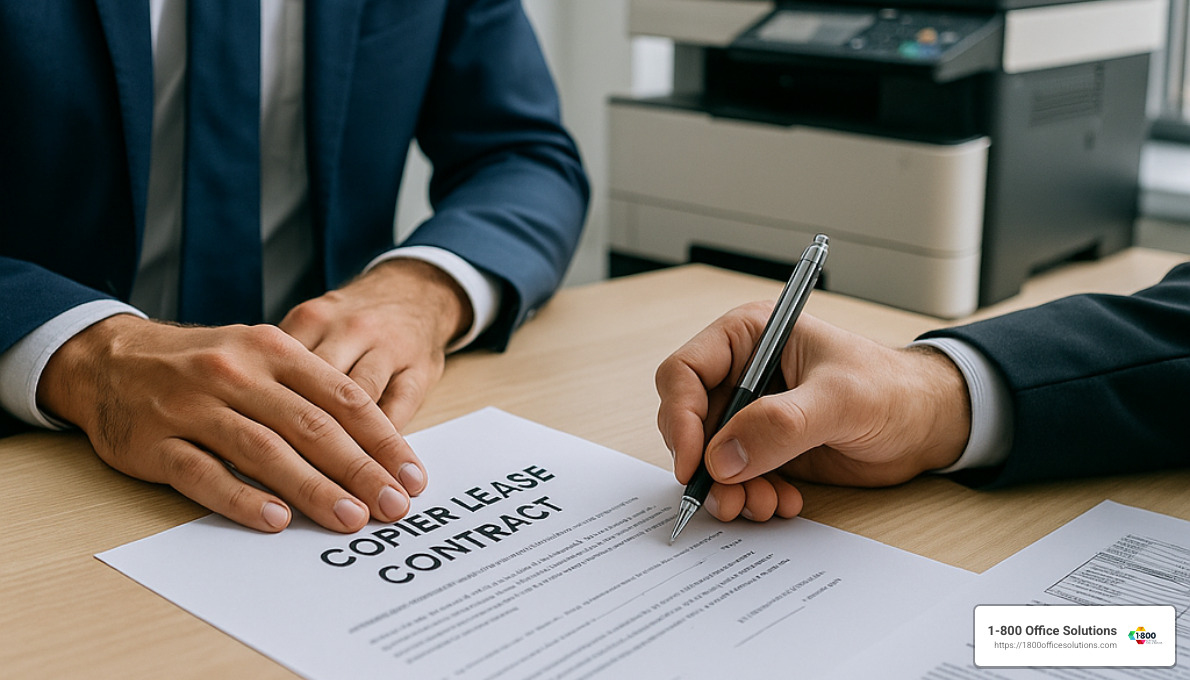
Service & Maintenance Essentials
A thoughtful service agreement keeps your equipment running smoothly and helps control costs over the life of your lease. Here’s what our experience has taught us:
Separate contract advantages can’t be overstated. Our service director puts it plainly: “Keep the maintenance agreement separate from the lease so you can adjust copy allotments; if bundled, your payment and allotment are locked with 10% yearly increases.” This separation provides valuable flexibility as your business needs evolve. A restaurant chain in Michigan initially needed high volume during their launch phase but was able to reduce their service agreement costs as operations stabilized—all while maintaining the same equipment lease.
Watch out for those annual increase caps. The standard industry practice includes 10% annual increases in service costs, which can add up dramatically over time. Our contract specialist in Raleigh suggests, “Negotiate prior to signing to avoid annual hikes.” Many of our customers have successfully secured fixed-rate agreements or caps of 3-5% instead of the standard 10%.
Next-day service standard is common, but response times vary significantly by location and provider. In metropolitan areas like Miami or Detroit, same-day service may be available, while rural locations might face longer waits. Be realistic about your needs—if your business grinds to a halt without copying capabilities, prioritize faster response guarantees.
Remote monitoring options represent the cutting edge of copier maintenance. Advanced service plans include remote diagnostics and monitoring, allowing technicians to address issues before they cause downtime. Our technical support manager explains the advantage: “Our systems can detect potential problems and dispatch technicians proactively, often resolving issues before clients even notice them.” One medical practice in Orlando estimated they avoided at least three major breakdowns last year thanks to preventive service triggered by remote monitoring.
At minimum, comprehensive maintenance agreements should include:
- Toner and supplies (except paper and staples)
- All parts and labor
- Regular preventive maintenance
- Emergency repair service
Be aware that these agreements typically exclude:
- Paper and staples
- Network support beyond initial setup
- Damage from misuse or environmental factors
- Third-party accessories
An industry consultant we work with warns, “Hidden fees can include 10% annual increases, travel fees per service call, and shipping fees for toner if not explicitly included.” Always review these details before signing to avoid unwelcome surprises down the road.
End-of-Lease FAQs & Next Steps
The end of your copier lease might seem far away when you first sign the agreement, but those final months will arrive before you know it. Understanding what happens as your lease winds down helps you avoid unexpected costs and make smart decisions about your next steps.
Return Logistics can be straightforward if you’re prepared. Most leases require returning the equipment in good working condition – normal wear and tear is expected, but significant damage could trigger additional charges. The leasing company typically handles the pickup coordination, but don’t be surprised if you’re responsible for some of the costs.
“Budget $200-$500 for return shipping depending on equipment size and location,” advises our logistics coordinator. This is especially important if you’re not renewing with the same vendor, as they’ll have less incentive to absorb these costs.
When your lease approaches its end, you’ll generally have three choices:
- Return the equipment and end the relationship
- Purchase the equipment (at fair market value for FMV leases, or $1 for buyout leases)
- Upgrade to new equipment under a fresh lease
But here’s where many businesses get caught: Evergreen Clauses. These automatic renewal provisions can extend your lease (often at the same monthly rate) if you don’t provide timely notification that you want to end the agreement.
“These ‘evergreen clauses’ can trap unwary businesses in extended commitments,” cautions our contract specialist. “I’ve seen clients locked into another year of payments simply because they missed a notification deadline.”
The solution? Follow the Letter of Intent 90-Day Rule. To avoid automatic renewal, you need to send a formal Letter of Intent (LOI) 90-120 days before your lease expires. This isn’t just a casual email – it needs to follow specific protocols.
“Your LOI must be on company letterhead, signed and sent by fax/email,” explains our customer service representative from Philadelphia. “And if you miss the deadline, don’t panic – contact the leasing company or your advisor immediately to discuss options.”
Don’t forget about Tax Records either. Maintaining complete documentation of all lease payments ensures you capture the tax benefits of your affordable copier leasing agreement. Since these payments are typically deductible business expenses, good record-keeping can save you money at tax time.
A marketing firm in Atlanta shared their close call: “We nearly missed our notification window and would have been locked into another year. Thankfully, our account manager at 1-800 Office Solutions alerted us in time to send our LOI and smoothly transition to a newer, faster model.”
Can I Upgrade Mid-Term?
Business needs change – sometimes faster than your lease term. What happens when your trusty copier no longer meets your growing requirements, but you’re only halfway through your lease?
Add-On Device Strategy might be your simplest solution. Rather than replacing your current equipment and dealing with the complications of breaking a lease, consider adding a supplemental device for those new capabilities you need.
“Businesses often add a backup device to maintain uptime,” notes our sales director in Chicago. This approach lets you keep your existing lease intact while expanding your capacity or capabilities. It’s particularly useful when you need additional features like color printing or higher volume capacity.
Be wary of Balance Roll-Over Pitfalls though. Some companies tempt customers with offers to roll remaining payments into a new lease. While this seems convenient, you’re essentially financing old debt alongside new equipment.
“What should I do if the copier company wants to upgrade my copy equipment early? Decline rolling your remaining payments into a new lease; always finish the term of your lease to avoid financing old debt,” advises our financial consultant. This approach might feel like you’re getting a fresh start, but you’re actually paying for equipment you’re no longer using.
Some manufacturers offer special Manufacturer Upgrade Programs for existing customers. These brand-backed options from Canon, Xerox, and HP sometimes provide more favorable terms than standard mid-lease upgrades, so they’re worth exploring if you’re in a bind.
For creative thinkers, Sublease Possibilities might be an option. In some cases, you can sublease your current equipment to another business while securing new equipment under a fresh lease. This requires lessor approval but can be a win-win solution when it works.
A law firm in Kalamazoo found a practical middle ground: “When we unexpectedly needed color capabilities mid-lease, 1-800 Office Solutions helped us add a small color device while keeping our existing black and white copier. This hybrid approach saved us thousands compared to breaking our lease.”
What Happens to My Data?
That innocent-looking copier in your office holds more secrets than you might realize. Modern digital copiers store images of every document they process – from sensitive financial statements to confidential employee information.
Hard-Drive Wipe is essential before returning any equipment. These internal storage devices can contain thousands of document images that could create serious privacy and compliance issues if not properly handled.
“We ensure every returned copier undergoes a complete hard drive wipe meeting Department of Defense standards,” explains our security specialist. “Many businesses don’t realize their liability doesn’t end when the copier leaves their office.”
Always request a Security Certificate documenting that all data has been properly erased. This documentation provides proof of compliance with data protection regulations and should become part of your permanent records – especially important if you ever face an audit or legal inquiry.
For businesses handling particularly sensitive information, Removal Options provide additional peace of mind. Some leasing companies offer the option to purchase and retain the hard drive, providing absolute certainty about data security. This typically costs $150-$300 but may be worth every penny for businesses in regulated industries.
Speaking of regulations, Compliance Considerations are paramount for certain sectors. Businesses in healthcare, financial services, legal, and government have specific regulatory obligations regarding data security. Your lease-end procedures must satisfy these requirements to avoid potential penalties.
A medical practice in Winston-Salem took no chances: “HIPAA compliance is non-negotiable for us. Our lease agreement included provisions for certified data destruction at lease end, with documentation we could include in our compliance records. The small additional cost was well worth the protection it provided.”
How Do I Avoid Renewal Traps?
Automatic renewals are the silent budget-killers that catch even experienced business managers by surprise. Here’s how to stay in control of your affordable copier leasing agreement:
Set multiple Calendar Alerts at 120, 90, and 60 days before lease expiration. “We create calendar notifications for all our clients to ensure timely decision-making,” notes our account management team. “The first alert at 120 days gives you time to start exploring options, while the 90-day reminder is your critical deadline for notification.”
When sending your notification, use Certified LOI Delivery methods that provide proof the document was received. Send your Letter of Intent via certified mail or email with read receipt to document delivery.
“Even after sending our LOI by email, we followed up with a phone call to confirm receipt,” advises a business owner from Detroit. “This extra step prevented any claims of non-notification and gave us peace of mind that we wouldn’t face unexpected renewal charges.”
Start the conversation early with Early Renegotiation. Begin discussions about renewal or replacement 6 months before lease end. This provides leverage and prevents last-minute decisions that rarely work in your favor.
“Starting early gave us time to compare multiple options and negotiate more favorable terms for our renewal,” reported a nonprofit director from Jacksonville. “When vendors know you’re actively shopping around, their offers tend to improve dramatically.”
Throughout the process, Document Everything. Keep records of all communications regarding lease end, including names, dates, and content of conversations. This documentation proves invaluable if disputes arise later – and they sometimes do, even with reputable companies.
When signing your next lease, carefully Review Auto-Renewal Language. Pay special attention to these clauses and negotiate to remove them entirely if possible, or at least extend the notification period to 60 days instead of the standard 90-120 days. A shorter notification window gives you more flexibility as you approach lease end.
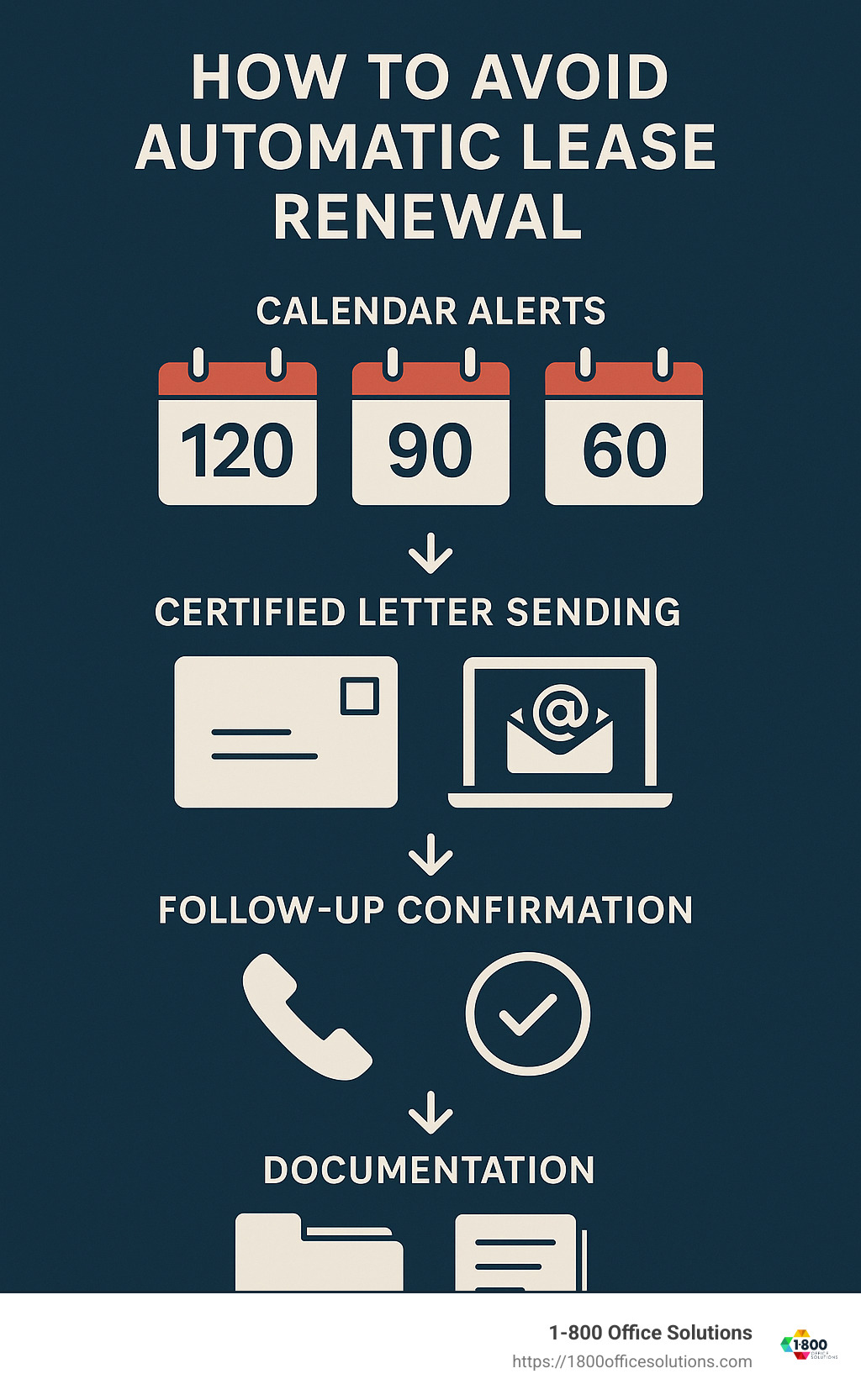
Conclusion
When it comes to equipping your office with essential technology without draining your capital resources, affordable copier leasing simply makes sense. Throughout this guide, we’ve explored how leasing provides a strategic advantage for businesses of all sizes – from startups in Miami to established firms in Detroit, and everyone in between.
The benefits of leasing extend far beyond just avoiding a large upfront purchase. You’ll enjoy predictable monthly payments that help stabilize your cash flow and make budgeting a breeze. Instead of watching your purchased equipment become outdated, leasing gives you the freedom to access current technology and upgrade as innovations emerge. As your business grows and evolves, your equipment can scale right alongside you without painful transition periods or unexpected expenses.
Many of our clients are pleasantly surprised by the tax advantages too. In most cases, you can deduct 100% of your lease payments as business expenses, providing immediate tax benefits rather than the complicated depreciation schedules that come with purchased equipment.
I’ve seen countless businesses transform their operations through smart leasing decisions. One accounting firm in Philadelphia told me, “Bundling our equipment, maintenance, and supplies into one monthly payment eliminated so many headaches – no more tracking multiple vendors or dealing with surprise repair costs.”
Remember these essential strategies as you move forward:
First, take time to honestly assess your actual printing and copying needs. Many businesses overestimate their volume requirements and end up paying for capacity they never use. Second, never accept the first quote you receive – comparison shopping can save you thousands over the life of your lease. Third, don’t be afraid to negotiate aggressively on terms like auto-renewals and annual service increases – these seemingly small details can have major financial implications.
If your budget is particularly tight, consider refurbished equipment. One of our clients, a nonprofit in Lansing, saved nearly 40% by leasing a certified refurbished unit that performed beautifully for their entire lease term. And whenever possible, keep your service agreements separate from your equipment lease – this gives you the flexibility to adjust service levels as your needs change without disrupting your equipment financing.
Perhaps most importantly, mark your calendar now for timely end-of-lease notifications. The number one complaint we hear from businesses switching to us involves automatic renewals that trapped them in extended commitments. A simple calendar reminder can save you significant money and hassle.
At 1-800 Office Solutions, we’ve helped thousands of businesses nationwide implement custom copying solutions that align perfectly with their unique operational needs and budget constraints. Our coast-to-coast presence ensures you’ll receive consistent service and support regardless of your location.
Ready to explore how affordable copier leasing can benefit your specific business situation? Our team is standing by to provide a personalized consultation and no-obligation quote. We’ll help you steer the options and secure terms that keep your business productive without breaking the bank.





